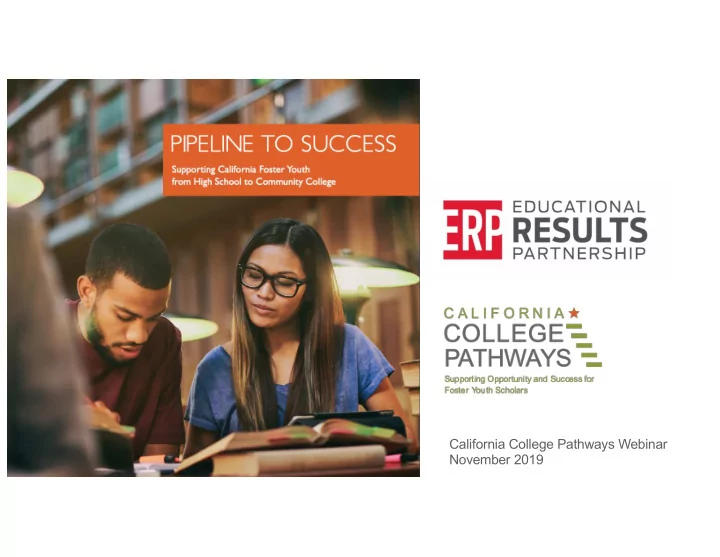

California College Pathways Webinar November 2019
In Inform rmation to Part rticipate Today’s PowerPoint can be downloaded from • the ”handouts” section of your control panel To submit questions, click on the “Questions” • panel, type your question, and click “send” Presentation materials and audio will be posted • at www.jbaforyouth.org
Pipeline to Success Supporting California Foster Youth from High School to Community College • Background of this Work & Research • Key Demographic Information • Findings • Recommendations • Questions
Funders and Partners
• 501(c)(3) non-profit organization that applies data science to help improve student outcomes and career-readiness • Founded in 2001 as a forum for educators and employers to align efforts and share best practices • All of our work is done through an equity lens • Manage the Cal-PASS Plus system of data
Background on this Research Series Charting the Course: Using Data to Support FY College Success – 2015 Accelerating Success: Turning Insights into Action for FY at California Community Colleges – 2017 Pipeline to Success: Supporting California FY from High School to Community College – 2019
Research Questions This report links K-12 and community college data to address the following questions: 1. How do foster youth compare to their peers in transitioning from high school to community college? 2. What factors predict success along the transition between high school and community college? 3. What barriers or risk factors contribute to the equity gap between foster youth and their peers in transitioning from high school to college?
Key Demographic Information
Equity gaps in high school achievement persist for foster youth
Equity gaps in high school achievement persist for foster youth
Throughout high school, foster youth experience barriers that impede academic success
Foster youth are applying to college at high rates but many do not subsequently enroll
What relates to first-year community college success for both foster & non-foster students?
First-Year Outcomes What Relates to First-Year Community College Outcomes for Foster Youth? Start of First-Year
First-Year Outcomes for Foster Youth After accounting for the previous factors and additional demographic factors, there was still a gap in first-year community college outcomes for foster youth. -0.33 GPA -3.97 Units
In their first year of community college, foster youth are not performing at the same level as their peers
Efforts to increase foster youth access to financial and academic services are working
Recommendations Reduce school mobility for foster youth • Ensure a best interest determination process (BID) that includes • An education rights holder is available for all students • Developing cost sharing agreements and transportation plan templates • Documenting processes for sending and receiving students between schools
Recommendations Address suspensions and exclusions for foster youth in high school • Re-examine existing suspension/exclusion procedures • Prioritize trauma informed training for all school personnel
Recommendations Provide funding for foster youth specific supports within K-12 systems • Provide dedicated financial resources for supporting foster youth within K-12 systems
Recommendations Develop strategies to reduce summer melt • High schools and colleges should develop and implement strategies and programs that specifically focus on reducing this lack of momentum for foster youth
Recommendations Increase access to financial supports for foster youth in community college • Ensure access to financial support for tuition and daily life expenses • Targeted efforts toward getting foster youth into these financial aid programs
Recommendations Ensure foster youth have access to educational support services • Ensure foster youth have access to counseling and advising services and have the tools to create an education plan
Recommendations Create data systems that allow data sharing across K-12, colleges, and child welfare to enhance the identification of foster youth in college systems • Systematic linkage of data from the multiple systems to provide better insights and support for foster youth • In this study, about 63% of foster youth in 12 th grade that went on to community college self-identified as foster youth
Want to learn more? Electronic version on California College Pathways and ERP websites
Thank You! Your commitment to improving the lives of foster youth students inspires us to continue our work leveraging data to accelerate success for this historically disadvantaged population. Elle Gemma Gruver Palvinder Dhillon VP of Strategy & Development Project Coordinator II egruver@edresults.org pdhillon@edresults.org Marissa Kraynak Research Analyst mkraynak@edresults.org Question & Answer CLICK ON THE “QUESTIONS” PANEL, TYPE AND HIT “SEND”
Recommend
More recommend